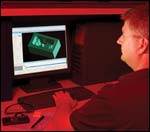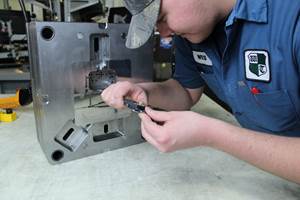Molding Success Through Automation
HSM technology helps U.S. moldmaker maintain world-class productivity and business growth.
Industry naysayers who claim moldmaking in the U.S. is dead should take a close look at Advance Mold and Manufacturing, Inc. (AM&M) of Manchester, CT, a “traditional” manufacturer with a very untraditional approach. Not only is their business thriving, they even produce molds for customers in Asia—a welcome switch in the face of current trends.
Speed and automation are primary factors in AM&M’s ability to compete globally as an American moldmaker. The recent addition of a fully automated, high-speed machining cell to their production capabilities helps AM&M slash customer leadtimes. The addition also fits into a strategic business plan that enables the company to not only compete but also achieve aggressive annual growth targets.
Combined Capabilities, Unique Assets
AM&M, founded in 1959, is now located in an immaculate new temperature-controlled production facility in Manchester, CT. The 30,000 square-foot building also houses Vision Technical Molding (VTM), a custom molding operation specializing in complex, tight-tolerance medical products. VTM also QC-samples AM&M’s molds. Although the two sides are separate businesses, they also are partners, connected within the same building. AM&M uses 18,000 square feet of the building and employs 65 people working two shifts, six days-per-week. When AM&M needs a mold validated, they are just steps away from that capability—providing a key speed and accuracy advantage.
AM&M is larger than most precision moldmaking operations. It builds approximately 200 molds a year, machining as much as 300 tons of material, ranging from stainless steel to graphite electrodes for small, highly accurate mold components. About 20 percent of AM&M’s work goes next door to partner VTM.
At $11 million in annual sales and a consistent annual growth rate of more than 10 percent, Advance Mold is always on the move to stay abreast of new technology to help sustain their challenging growth curve. With success like this its easy to see why AM&M’s leader shrugs off the “China syndrome”.
“Competition from China is real and price is perceived as a significant factor,” observes Steven Arnold, President of Advance Mold and Manufacturing. “However, the cost difference between a Chinese-made mold and our product can diminish quickly when you factor in time, quality and service. We win on providing full-speed service for customers who can’t tolerate delays due to quality glitches, distance and de-bugging, or who have urgent design change needs.”
Arnold believes AM&M’s competitive edge is the result of investing in state-of-the-art equipment and seeking out highly skilled people focused on realizing the full potential of advanced technology. His team has developed a reputation for uncompromising precision and an ability to meet aggressive delivery schedules. “We distinguish ourselves further with an ability to qualify even the most complicated molds in-house and perform complete first-article inspections,” notes Arnold. “That happens during ‘crunch’ time when no one wants to be waiting for word from Asia.”
AM&M handles an array of work, but is especially strong in complex precision components for markets with counter-cyclic demand patterns such as automotive, medical and consumer/electronics. AM&M benefits from this diversity because when demand from one segment falls off, it is likely that another segment will be taking up the slack.
While AM&M is clearly committed to American manufacturing, the realities of global competition mean customers are situated wherever their business strategies dictate. AM&M has customers operating molding plants in Mexico. But instead of moving to Mexico and displacing American jobs, they intend to bring their moldmaking support closer to them, as there are future plans to establish an AM&M mold plant in Mexico.
Advancing to HSM
Pressure on throughput and ever more stringent demands for precision convinced AM&M to add a state-of-the-art HSM (high-speed machining) cell to their extensive equipment list. In February 2005, AM&M installed two Mikron HSM 400s mated to an automated 10-position pallet system and the capacity to hold 90 electrode holders with robotic support. The three-axis, 42,000-rpm vertical machining mills each have automated tool changers capable of holding 68 tools. Both units have full probing capabilities with laser tool measuring and compensation. A robot from Erowa Technology changes pallets when workpieces or setups change. It also automatically changes grippers when changing out graphite electrodes.
The Mikron mills are designed for precision and high throughput. Precision begins with rigidity, achieved with a monoblock machine base set in polymer concrete. It is the basis for solid damping in an accessible and compact mill. Equipped with high-performance motor spindles providing varying speed and torque, the Mikron HSM 400 machines most any material using a broad range of tools.
Automation gives the new HSM cell its high throughput. Served by a robotic pallet system, the cell enables staging and setup during operation, extending the system’s production hours with much of the process conducted unmanned. For maximum flexibility, the Mikron 400s each use automated tool holders that are capable of three-second tool changes. This makes it practical to economically use tools with short operating times (drilling, countersinking, threading, etc.).
AM&M reports that installation and setup of the new HSM cell went smoothly since the system was specifically designed to work with the Erowa tooling robot. With the integration in place, AM&M progressed to start-up only four days after installation.
Quantum Leap in Productivity
The new mold cell replaces two bed-type mills that were struggling to keep up with production demands and quality standards. The equipment required hand-loading and extra operators. The moving weight and mass of the machine components compromised accuracy. Thermal creep, as the production room and equipment gained heat, required constant checking and compensation to stay true to specifications.
“It was clear the move to HSM would help us stay ahead of the technology curve,” says Arnold. “Today, we are focused on dramatically reducing AM&M’s leadtimes and increasing throughput while maintaining unquestionable accuracy.”
According to Vincent Brown, CNC electrode/high speed mill department manager, the new HSM cell has done just that. “With the new HSM cell, we’ve seen our capacity grow by nearly 300 percent,” he notes. “We like what the new programming software has delivered too. The ability to change priorities, easily enter new jobs into the system and remotely monitor operations achieved dramatic improvements.”
Setup time has been minimized due to a high degree of integration between the Mikron 400s and the robot. Mold parts are being made in half the previous manufacturing time. The two mills are averaging a combined 240 production hours per week—much of it lights-out. Accuracy and repeatability are significantly improved.
“We can put up to 100 electrodes of different shapes and sizes in the system,” explains Brown. “The laser probe offsets the Z position and the machine does the rest automatically, unattended. The new cell has made life so much easier compared to our previous electrode milling machines.”
“The speed, accuracy and repeatability achieved by the new HSM cell has given our staff a very high level of confidence,” observes Arnold. “They are able to concentrate on keeping the cell running as opposed to calibrating, checking and making the frequent adjustments that were previously required.” Brown adds, “Throughput is so much improved that ironically, the increased number of finished workpieces sometimes causes bottlenecks in inspection.”
Capabilities Customers Appreciate
In addition to the productivity gains, AM&M has achieved a new level of flexibility that appears to have the makings of a competitive edge. The system software allows mid-production changes that would be difficult or impossible to handle with conventional mold milling systems.
“Recently a customer called with an engineering change on a consumer electronics job two weeks into production,” explains Arnold. “We were able to quickly re-prioritize our work already in process in the machining cell. We met their needs with little or no impact on the final delivery.”
Arnold says mid-production engineering changes are happening more frequently due to the intensely competitive marketplace and the ever-shortening product lifecycles manufacturers face. AM&M’s HSM system software not only enables “on-the-fly” changes, it even provides for remote monitoring and alerts.
“I regularly check our job status from home,” Brown points out. “But the system also is capable of alerting me of a change or decision point. I can stop production of one phase due to a pending change and move on to the next job in line. There is very little lost production time.”
More Automation in the Works
AM&M has long been a customer of Charmilles and now Mikron, maker of the Mikron HSM 400. Their equipment includes two Charmilles wire EDMs, four Charmilles CNC sinkers and four manual Charmilles sinkers. “The Charmilles equipment is highly accurate, easy-to-run and highly productive,” Arnold observes.
In the near future, AM&M plans to automate production flow by linking the HSM cell to the Charmilles CNC sinkers. Like the HSM cell, the Charmilles equipment is currently running unmanned during second shift operations with remote monitoring. Once the new software has the two operations talking and working together, AM&M expects another boost in productivity.
“Combining our HSM cell with our EDM department is the next logical step in our automation strategy,” states Arnold. “It brings together the right combination of processes for meeting customer requirements and maintaining our competitive position.”
Remaining competitive is what the addition of HSM and its imminent link-up with EDM is all about. Arnold sums up the impact on AM&M succinctly, “Our capabilities enable us to provide a fast four-week leadtime on new mold builds, even with complex, multi-action molds,” he states. “With accuracy and surface finish quality as ‘givens,’ production turn-around either makes or breaks you in today’s market. Speed is definitely a key factor to our success.”
Related Content
Machine Monitoring Platform Improves Machine Utilization, On-Time Delivery
Using data from a machine monitoring platform, Westminster Tool added almost 75 hours of capacity per week by shortening warmups and starting CNC and EDM machines sooner.
Read MoreMachining and EDM Innovations to Look for at IMTS
MoldMaking Technology previews some of the EDM and machining products and exhibitors applicable to mold builders that will be featured at IMTS 2022.
Read MoreMaintaining a Wire EDM Machine
To achieve the ultimate capability and level of productivity from your wire EDM on a consistent, repeatable and reliable basis, regular maintenance is a required task.
Read MoreProducts and Services for Multiple Moldmaking Needs
New year, new technology roundup! Featured here is a collection of product offerings, from profile milling cutters to industry-specific CAD/CAM software to innovative hot work tool steels.
Read MoreRead Next
Doubling and Quadrupling Machining Speed, Capacity and Output
Vertical machining centers help to achieve the rapid tool production time a medical thermoformer’s customers demand.
Read MoreHow to Use Continuing Education to Remain Competitive in Moldmaking
Continued training helps moldmakers make tooling decisions and properly use the latest cutting tool to efficiently machine high-quality molds.
Read MoreAre You a Moldmaker Considering 3D Printing? Consider the 3D Printing Workshop at NPE2024
Presentations will cover 3D printing for mold tooling, material innovation, product development, bridge production and full-scale, high-volume additive manufacturing.
Read More












.jpg;maxWidth=300;quality=90)




_300x250 4.png;maxWidth=300;quality=90)










.jpg;maxWidth=970;quality=90)